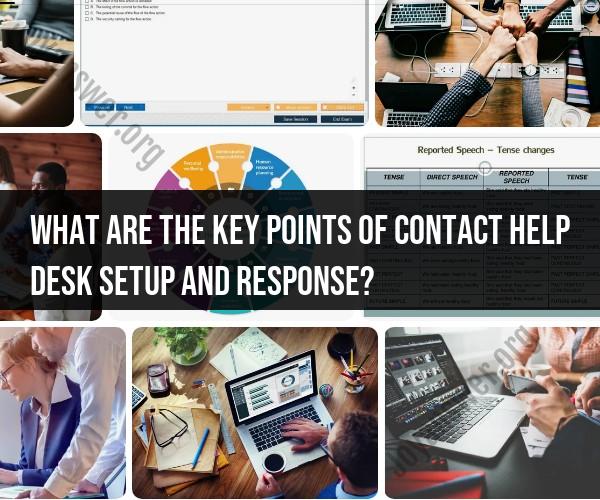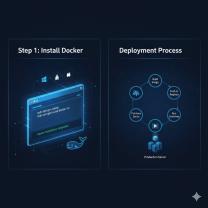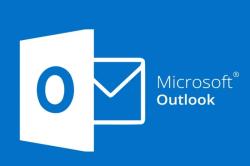What are the key points of contact help desk setup and response?
Setting up and operating an effective help desk involves several key points of contact and a well-defined response process to address customer inquiries, technical issues, and support needs. Here are the key points of contact help desk setup and response:
1. Clear Objectives and Goals:
- Define the primary objectives and goals of your help desk, such as response time targets, issue resolution times, and customer satisfaction benchmarks.
2. Knowledgeable Staff:
- Employ skilled and knowledgeable staff members who are well-versed in the products, services, or systems they are supporting.
3. Multichannel Support:
- Offer support through multiple communication channels, including phone, email, chat, and ticketing systems, to accommodate various customer preferences.
4. Ticketing System:
- Implement a ticketing system to track and manage customer inquiries and issues efficiently. Each inquiry should be assigned a unique ticket for easy tracking.
5. Customer Onboarding:
- Ensure smooth onboarding and training processes for new customers. Provide resources and documentation to help them navigate your products or services.
6. Knowledge Base:
- Develop and maintain a comprehensive knowledge base that contains FAQs, troubleshooting guides, and instructional articles for both customers and help desk staff.
7. Support Team Structure:
- Establish a clear support team structure with roles and responsibilities, including tiered support for escalating complex issues.
8. Issue Categorization:
- Categorize and prioritize issues to ensure that critical problems are addressed promptly. Consider using service level agreements (SLAs) to define response times for different issue types.
9. Continuous Training:
- Provide ongoing training and professional development opportunities for help desk staff to stay up-to-date with evolving products and technologies.
10. Remote Support Tools:- Equip your support team with remote desktop tools and screen-sharing capabilities to assist customers with technical issues in real-time.
11. Communication Skills:- Train staff in effective communication and customer service skills to ensure positive interactions with customers.
12. Escalation Process:- Develop a clear escalation process for handling issues that cannot be resolved at the initial support level.
13. Performance Metrics:- Establish key performance indicators (KPIs) to measure the efficiency and effectiveness of your help desk, including response times, resolution rates, and customer satisfaction scores.
14. Customer Feedback:- Gather feedback from customers to assess their satisfaction and identify areas for improvement.
15. IT Infrastructure:- Ensure that your IT infrastructure, including servers, network connections, and software, is robust and reliable to support the help desk's operations.
16. Security and Privacy:- Implement data security and privacy measures to protect customer information and maintain compliance with relevant regulations.
17. 24/7 Availability:- Consider offering round-the-clock support for customers in different time zones or industries that require continuous assistance.
18. Documentation and Reporting:- Maintain detailed records of customer interactions and resolutions, which can be used for analysis and reporting to identify trends and areas for improvement.
19. Problem-Solving Tools:- Equip your support team with diagnostic and problem-solving tools to expedite issue resolution.
20. Post-Incident Analysis:- Conduct post-incident analysis to identify the root causes of recurring issues and implement preventative measures.
A well-structured help desk that focuses on these key points of contact and response will provide efficient, effective, and customer-friendly support, contributing to higher customer satisfaction and loyalty.
Setting Up an Effective Help Desk: Key Contact Points and Response
A well-structured help desk serves as the central hub for customer support, providing a seamless experience for resolving inquiries and addressing concerns. Establishing an effective help desk involves:
Diverse Contact Points: Offer multiple channels for customers to reach the help desk, including phone, email, live chat, and social media.
Timely Response: Set clear expectations for response times and prioritize prompt acknowledgment of incoming requests.
Omnichannel Support: Ensure consistent support across all contact channels, maintaining a unified customer experience.
Creating a Responsive Help Desk: Essential Components
A responsive help desk requires a combination of technology, processes, and people to deliver exceptional customer service:
Knowledge Base: Develop a comprehensive knowledge base with self-service options for common issues and FAQs.
Ticketing System: Implement a robust ticketing system to track, manage, and prioritize customer requests efficiently.
Trained Staff: Invest in training and empowering help desk agents with the knowledge and skills to handle diverse inquiries.
Customer Support Excellence with a Well-Established Help Desk
A well-established help desk can elevate customer support to a higher level by:
Proactive Engagement: Anticipate customer needs and proactively provide solutions before issues arise.
Personalized Interactions: Treat each customer as an individual, understanding their unique needs and tailoring support accordingly.
Empathetic Communication: Practice active listening and empathy to build rapport and foster customer loyalty.
Contact Help Desk Best Practices for Customer Satisfaction
Adopting best practices can significantly enhance customer satisfaction:
Clear Communication: Use clear and concise language, avoiding technical jargon and explaining solutions in simple terms.
Problem-Solving Expertise: Possess in-depth product knowledge and problem-solving skills to address complex issues effectively.
Customer-Centric Approach: Prioritize customer satisfaction, going the extra mile to resolve issues and exceed expectations.
Navigating Help Desk Challenges with Strategic Response
Effectively addressing help desk challenges requires strategic planning:
Managing Volume: Implement strategies to handle high volumes of requests, such as prioritizing urgent issues and utilizing self-service tools.
Complex Issues: Develop escalation procedures for handling complex or technical issues, involving specialized support teams when necessary.
Customer Feedback: Continuously gather customer feedback to identify areas for improvement and refine help desk operations.
By establishing a responsive help desk, prioritizing customer satisfaction, and continuously refining processes, businesses can foster a reputation for exceptional customer support and build lasting relationships with their clientele.













